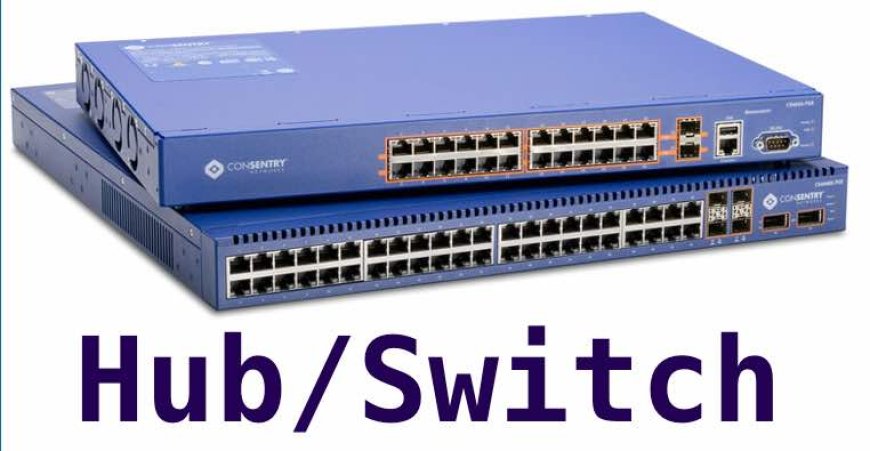Hubs & Switches: Core Components in Computer Networking
Explore the differences between hubs & switches, their roles in IT hardware, and how they impact computer networking performance and infrastructure.

In the digital era, the importance of efficient and reliable networking cannot be overstated. As the backbone of communication in businesses, schools, and homes, networks depend on certain key components to ensure smooth data transmission. Among these components, hubs & switches play a vital role in connecting multiple devices, forming the infrastructure that allows seamless communication within a local area network (LAN). Whether you're a student of IT, an aspiring network administrator, or a small business owner building your infrastructure, understanding the functions and differences of hubs & switches is essential.
Understanding IT Hardware in Networking
Before diving into hubs & switches specifically, its essential to grasp the context in which these devices operate. IT hardware refers to the physical components of a computer system or network. This includes computer hardware like servers, workstations, cables, routers, and more. Within the realm of networking, hubs & switches are integral parts of networking hardware, often forming the core of LAN infrastructure.
These devices allow different computers and peripherals to connect, share resources, and access the internet or internal servers. While they may seem interchangeable to some, hubs & switches serve distinct purposes and have different capabilities.
What is a Hub?
A network hub is a basic piece of networking hardware that connects multiple Ethernet devices, making them act as a single network segment. Hubs operate on Layer 1 (the physical layer) of the OSI model. When a hub receives a data packet from one of its ports, it broadcasts the packet to all the other ports without checking the destination. This means every device connected to the hub receives the data, regardless of whether its the intended recipient.
Advantages of Hubs:
-
Simple and easy to install
-
Cost-effective
-
Useful for basic home networking or troubleshooting
Disadvantages of Hubs:
-
Not intelligent they can't filter data
-
Network collisions are common
-
Slow performance with higher traffic
-
Not secure since data is sent to all devices
Because of these limitations, hubs have largely become obsolete in modern computer hardware infrastructure, replaced by more efficient devices like switches.
What is a Switch?
A network switch is a more advanced device that connects devices within a network and uses MAC addresses to forward data only to the specific device it is intended for. Operating on Layer 2 (the data link layer) of the OSI model, some advanced switches also function on Layer 3 (the network layer), making them capable of routing functions.
Unlike hubs, switches learn the MAC addresses of connected devices and create a MAC address table to intelligently forward traffic. This reduces unnecessary data transmission, increases efficiency, and minimizes the chance of data collisions.
Advantages of Switches:
-
Intelligent data handling
-
Better performance and speed
-
Higher security through targeted communication
-
Supports full-duplex communication
Disadvantages of Switches:
-
More expensive than hubs
-
Slightly more complex setup and management
Switches are now a staple in modern networking hardware setups, whether in enterprise environments or home networks.
Hubs & Switches in IT Infrastructure
While hubs are mostly used for educational purposes or in very small networks, switches are widely adopted in businesses of all sizes. Their ability to efficiently manage and direct traffic makes them essential in ensuring reliable computer hardware performance.
In a standard office setup, a network switch connects all the PCs, printers, and servers. It manages the data flow, reduces congestion, and ensures that sensitive data reaches only its intended target, improving security and performance.
Networking Efficiency: Hub vs Switch
| Feature | Hub | Switch |
|---|---|---|
| OSI Layer | Layer 1 | Layer 2 (and Layer 3) |
| Data Transmission | Broadcasts to all devices | Sends data to specific device |
| Speed | Slower | Faster |
| Security | Low | High |
| Cost | Lower | Higher (but more cost-effective long-term) |
Switches significantly improve networking efficiency. For example, in a busy office where multiple video conferences and file transfers happen simultaneously, a switch ensures each data stream reaches its destination without interrupting others.
Future of Hubs & Switches
As the demand for high-speed internet and reliable networking hardware grows, switches continue to evolve. Managed switches, PoE (Power over Ethernet) switches, and smart switches are now available, offering features such as VLANs, QoS (Quality of Service), and remote monitoring.
Hubs, on the other hand, are rarely used outside of specific niche or legacy environments. However, understanding how hubs work is still valuable for educational purposes and legacy system management.
Choosing the Right Networking Hardware
When setting up a network, whether at home or in an office, it's crucial to choose the right IT hardware. While switches are generally the preferred choice, understanding the limitations and capabilities of both hubs & switches helps in making informed decisions.
Things to consider when selecting between a hub and a switch:
-
Size and scope of the network
-
Security requirements
-
Budget constraints
-
Future scalability
For most modern applications, switches provide the speed, control, and reliability required to handle todays data demands.
Conclusion
In summary, hubs & switches are foundational components in the world of computer hardware and networking. While hubs offer basic functionality, switches have become the standard in efficient and secure network management. Understanding the differences between these two devices is vital for anyone involved in IT infrastructure or interested in IT hardware solutions.
As businesses and homes become more connected, ensuring your network is built on reliable and intelligent hardware like network switches will pay off in performance, security, and scalability. Whether you're building a new system or upgrading an old one, hubs & switches are topics worth mastering.




































